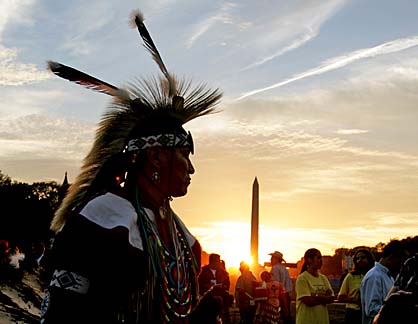— ADVERTISEMENT —


|
Native tribes
celebrate museum
Hawaiians attend the opening
of the facility in the nation's capital
WASHINGTON » To thundering drums, jubilant whoops and bell-jingling dancers, the Smithsonian yesterday opened the National Museum of the American Indian, dedicated to the history, culture and painful travails of native people in the Western Hemisphere.
With the glistening dome of the Capitol as a backdrop, more than 20,000 people from Alaska to Peru paraded across the Mall to witness the event. Some 400 Native Hawaiians joined the half-mile procession.
Under gauzy blue skies, they formed a brilliant river of deerskin jackets, feathered headdresses and beaded skirts, in conflict with Washington's pinstriped style.
The opening capped a 17-year quest by tribal leaders and elected officials to commemorate Indian culture and history in the capital. Housed in a yellow limestone building with wave-shaped walls at the southeastern corner of the Mall, the museum expects to draw more than 4 million visitors a year.
There have been some rumblings of discontent with the museum. Some people have complained about its truncated treatment of native history, while others have expressed dismay that casino money is helping to defray its $219 million price tag. Some Indians oppose gambling on Indian land.
But yesterday's event was overwhelmingly celebratory. Their voices cracking with emotion, visitors likened the gathering to a joyous family reunion, calling it a long-overdue tribute to native perseverance in the face of disease, war and colonization.
"It's more than all the colors and feathers, it's about coming home the way it should have been a long time ago," Pamela Best Minick of the Cherokee and Pottawattamie tribes of Illinois said, tears streaming down her face. "To come back in the same way and have people not laugh but respect you -- it shows we've come full circle."
Sen. Daniel Inouye, who sponsored the Senate bill authorizing the museum, said he was motivated by a sense that Indians had been unrecognized in the nation's capital.
"In this city of monuments there was no statue, no monument, honoring the first Americans," Inouye told the assembled crowd as dragonflies darted about in the bright sunshine. "This monument to the first Americans is long overdue."

|
The day began with a three-hour procession from the Smithsonian castle to the front of the new museum. Smithsonian officials estimated that nearly 25,000 people participated in the parade, while tens of thousands more gathered to watch.
Haunani Apoliona, chairwoman of the Office of Hawaiian Affairs, said the gathering made it clear "that we have these common ties."
"We all are so proud and humble and appreciate the respect," said Apoliona, who noted that the museum's place on the National Mall was a great honor.
"The last space for the first people," she said.
One group of Chippewa women from the Lac Du Flambeau band of Lake Superior Chippewa in Wisconsin wore colorful dresses fringed with silver bells made from discarded chewing tobacco tins. Behind them, five men wearing baseball caps thumped on a single drum while children wearing moccasins danced to the beat.
"For me, this is of immense spiritual significance," said Ann-Marie Evenson, 35, one of the tribe's members. "It's like a big family reunion."
Behind them walked a group from the Cheyenne River Lakota Akicita from South Dakota, led by several men wearing military fatigues.
"We are proud to serve," said Lyle Cook, 43, a former Army medic and Lakota tribe member. "We do it not to serve the Untied States, but to protect our people. This is still our land, even if it is called the United States."
There were Aztecs from Mexico wearing rattles around their ankles, young men in Metallica T-shirts chanting traditional songs and sun-weathered older people using digital cameras to record the festivities.
On the ground floor, a group of Hawaiians dressed in deep-red robes called kiheis, wearing necklaces made from black and white nuts, posed for pictures in front of a traditional Hawaiian canoe.
The Hawaiians, though not formally recognized by the federal government as a native tribe, were invited to participate in the opening festivities by the Smithsonian.
"There is a sense among native people of belonging," said Keone Nunes, from Oahu. "This museum will hopefully educate people that native people are still around."
The museum contains nearly 8,000 objects organized in three major exhibition spaces that focus on the histories, spiritual beliefs, daily lives and traditions of 24 tribes. Videotaped oral histories provide the narrative backbone to many displays. Over the coming years, the exhibits will rotate to feature other tribes.
In the exhibit called "Our Lives," a display on the Metis Indians of Saint-Laurent, Canada, includes an odd-looking vehicle used for ice fishing on Lake Manitoba. Called a Bombardier, the vehicle has tracks in the rear and skids in the front, portholes on the side and a rack filled with fishing gear on the roof.
Josh Gareau, an 18-year-old Metis, laughed when he saw it. "It's pretty weird to come all the way here and see all this stuff from our little town," he said. "It's pretty neat, too."
The New York Times and the Associated Press contributed to this report.
— ADVERTISEMENTS —
— ADVERTISEMENTS —